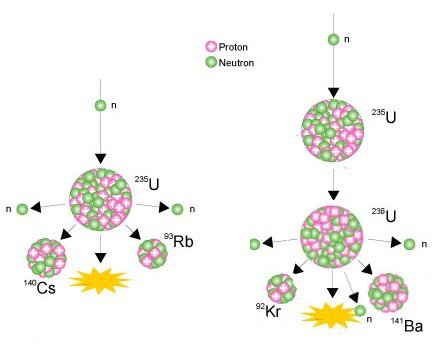A nuclear reactor produces and controls the release of energy from splitting the atoms of uranium. Uranium-fuelled nuclear power is a clean and efficient way of boiling water to make steam which drives turbine generators. Except for the reactor itself, a nuclear power station works like most coal or gas-fired power stations.
The reactor core:
Several hundred fuel assemblies containing thousands of small pellets of ceramic uranium oxide fuel make up the core of a reactor. For a reactor with an output of 1000 megawatts (MWe), the core would contain about 75 tonnes of enriched uranium. In the reactor core the uranium-235 isotope fissions or splits, producing a lot of heat in a continuous process called a chain reaction. The process depends on the presence of a moderator such as water or graphite, and is fully controlled.The moderator slows down the neutrons produced by fission of the uranium nuclei so that they go on to produce more fissions.

Two examples of fission of a uranium-235 atom
Some of the uranium-238 in the reactor core is turned into plutonium and about half of this is also fissioned similarly, providing about one third of the reactor's energy output.The fission products remain in the ceramic fuel and undergo radioactive decay, releasing a bit more heat. They are the main wastes from the process.The reactor core sits inside a steel pressure vessel, so that water around it remains liquid even at the operating temperature of over 320°C. Steam is formed either above the reactor core or in separate pressure vessels, and this drives the turbine to produce electricity. The steam is then condensed and the water recycled.
Common types of reactor:
The main design is the pressurised water reactor which has water in its primary cooling/heat transfer circuit, and generates steam in a secondary circuit. The less popular boiling water reactor makes steam in the primary circuit above the reactor core, though it is still under considerable pressure. Both types use water as both coolant and moderator, to slow neutrons.
ttp://www.world-nuclear.org/getattachment/Nuclear-Basics/How-does-a-nuclear-reactor-make-electricity/pwr.jpg.aspx
Diagram of pressurised water reactor
To maintain efficient reactor performance, about one-third or half of the used fuel is removed every year or two, to be replaced with fresh fuel.The pressure vessel and any steam generators are housed in a massive containment structure with reinforced concrete about 1.2 metres thick. This is to protect neighbours if there is a major problem inside the reactor, and to protect the reactor from external assaults.Because some heat is generated from radioactive decay even after the reactor is shut down, cooling systems are provided to remove this heat as well as the main operational heat output.
Natural prehistoric reactors:
The world's first nuclear reactors operated naturally in a uranium deposit about two billion years ago in what is now Gabon. These were in rich uranium orebodies in the Earth's crust and moderated by percolating rainwater. (At that time the uranium-235 isotope was more concentrated than it is today.)
Nuclear energy's contribution to global electricity supply:
Nuclear energy supplies about 11% of the world's electricity. Today 31 countries use nuclear energy to generate up to three quarters of their electricity, and a substantial number of these depend on it for one-quarter to one-third of their supply. Over 15,000 reactor-years of operational experience have been accumulated since the 1950s by the world's 440 nuclear power reactors (and nuclear reactors powering naval vessels have clocked up a similar amount).
the source:http://www.world-nuclear.org/nuclear-basics/how-does-a-nuclear-reactor-make-electricity.aspx
Hi! I am a robot. I just upvoted you! I found similar content that readers might be interested in:
http://www.world-nuclear.org/nuclear-basics/how-does-a-nuclear-reactor-make-electricity.aspx
Hi !, nuclear power is better to produce electricity, because it is less harmful to the environment than other sources of electricity